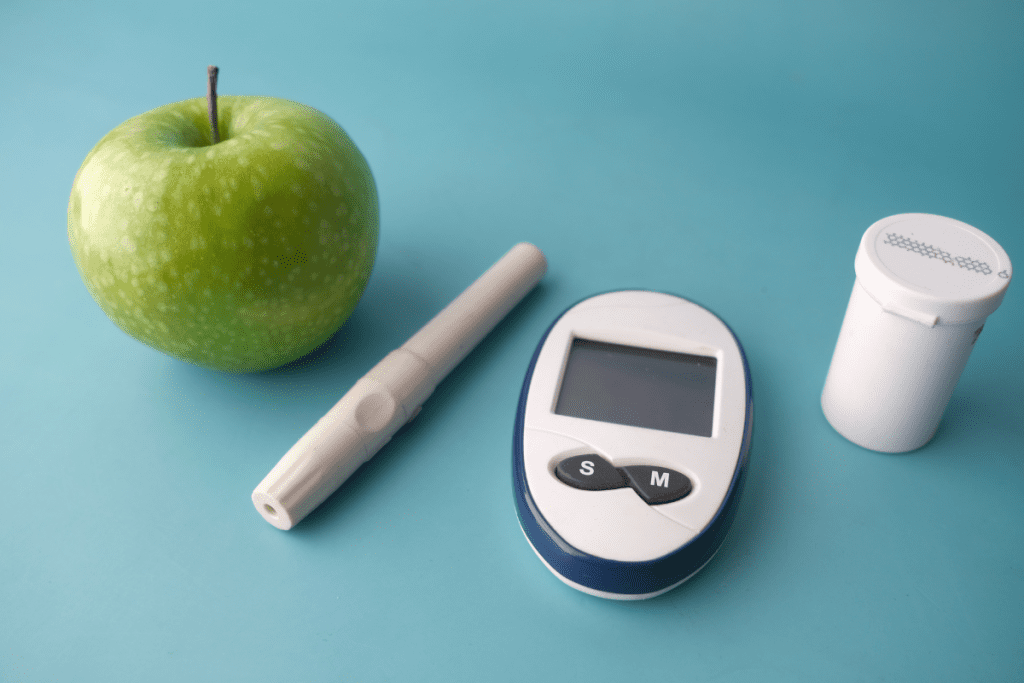Last Updated on November 14, 2025 by
At LivHospital, we know every child with pediatric diabetes needs a special care plan. Our protocols focus on personalized, evidence-based care. This helps keep blood sugar levels right, prevents problems, and helps kids grow well.

The Pediatric Diabetes Network and Canadian Pediatric Society stress the need for care that fits each child. Our methods follow global standards, like those from the American Diabetes Association (ADA). This ensures kids get the best care, including insulin and lifestyle changes.Symptoms of diabetes in children often guide treatment. Learn the standard protocol, diagnosis steps, and management methods.
Diabetes is becoming more common in kids. It’s important to know about its types and why it’s rising. Pediatric diabetes includes type 1 and type 2 diabetes, each with its own care needs.

Type 1 diabetes happens when the body attacks its own insulin-making cells. This leads to little insulin being made. Type 2 diabetes is when the body doesn’t use insulin well and may not make enough over time.
Type 1 diabetes is more common in kids. But type 2 diabetes is also on the rise, linked to more obesity and less exercise.
The number of kids with type 1 diabetes is going up worldwide. This is true for kids under five, as seen in Canada. The reasons for this increase are not clear, but genetics and environment likely play a part.
For type 2 diabetes, being overweight, not being active, and having a family history are risk factors. Obesity in kids is a big reason why type 2 diabetes is becoming more common in them.
Prediabetes is when blood sugar is higher than normal but not high enough to be called diabetes. It’s a growing concern in kids. Early action is key to stopping it from turning into type 2 diabetes. This includes eating better and being more active.
We aim to keep blood sugar close to normal to avoid serious problems. Knowing about diabetes types, their spread, and risk factors helps doctors act quickly and effectively.
It’s important to spot diabetes symptoms in kids early. This helps manage the condition better. Kids with diabetes show different signs, and knowing these can help their health.
Young children diagnosed with diabetes may experience excessive thirst and frequent urination. They could also feel fatigued and lose weight without any effort. Additionally, they might appear irritable, lethargic, or show signs of poor growth. Spotting these signs early is key to managing the condition well.
Teenagers with diabetes often have classic symptoms. These include drinking a lot of water, peeing a lot, feeling tired, and having blurry vision. They might also heal slowly and lose weight even when they’re hungry.
Seeing these symptoms early is important. It helps teens get the medical help they need to manage their diabetes.
If your child shows signs of diabetes, get them to a doctor fast. Early treatment is key to their long-term health.
See a doctor if you notice any diabetes symptoms in your child. Quick medical check-ups can find the cause and start the right treatment.

We aim to help kids with diabetes grow and develop normally. By knowing the symptoms and acting fast, parents and caregivers are essential in keeping kids with diabetes healthy.
Diagnosing diabetes in kids needs a mix of doctor checks and lab tests. This ensures we get the right results. We stick to proven methods to manage and diagnose diabetes in kids well.
Several tests are used to find diabetes in children. Random blood sugar tests and fasting blood glucose tests are common. The first checks blood sugar at any time, while the second requires fasting overnight.
These tests help doctors spot diabetes and keep an eye on blood sugar. Other tools might also be used to confirm the diagnosis. It’s key to follow established guidelines for accurate diagnosis and treatment.
Knowing normal blood sugar levels is key for diagnosing and managing diabetes in kids. For teens and kids, fasting blood sugar should be under 100 mg/dL. After eating, it should be under 140 mg/dL. These numbers can change based on age and other factors.
Doctors use these guidelines to see if a child’s blood sugar is normal or if they have diabetes. Keeping track of blood sugar levels is vital for managing diabetes well.
The A1C test shows blood glucose control over three months. For kids, the American Diabetes Association (ADA) sets specific A1C targets. Usually, kids with diabetes should aim for an A1C under 7.5%. But, this can change based on age, how long they’ve had diabetes, and if they have complications.
We follow pediatric A1C guidelines to make sure kids with diabetes get the right care. Checking A1C levels often helps doctors adjust treatment plans to keep blood sugar in check.
For kids, a normal A1C is usually under 5.7%. Levels between 5.7% and 6.4% might mean prediabetes. Levels of 6.5% or higher suggest diabetes. Knowing these guidelines is important for diagnosing and managing diabetes in kids.
Managing pediatric diabetes needs special care. We focus on personalized and evidence-based methods. This ensures each child gets the best treatment.
Insulin therapy is key for type 1 diabetes in kids. There are many ways to give insulin, like shots or pumps. The right method depends on the child’s life, blood sugar, and family wishes.
The Canadian Pediatric Society and the American Diabetes Association agree. They say each child’s needs should guide their insulin treatment.
Children with type 2 diabetes might take metformin or other medicines. The aim is to control blood sugar safely. The ADA has rules for using medicines in kids with type 2 diabetes.
They stress the need for constant checks and changes to the treatment plan.
Our treatment plans are made for each child. They follow the latest ADA standards. We consider the child’s life, needs, and wishes.
These plans are flexible and change as the child grows. Regular check-ups are key to keeping the plan working well.
Using evidence-based and personalized care improves diabetes management in kids. It helps them manage their condition better.
Pediatric diabetes care is a team effort. It includes using continuous glucose monitors and regular health checks. We know that keeping a close eye on diabetes is key to avoiding problems and helping kids grow well.
Continuous glucose monitoring systems (CGMS) have changed how we manage diabetes in kids. They give us real-time glucose levels. This helps doctors adjust insulin doses better and lowers the chance of blood sugar problems. These systems are great for kids because they show us how blood sugar changes over time.
The American Academy of Pediatrics (AAP) has rules for handling low blood sugar in diabetes. We stick to these guidelines to make sure kids with diabetes get the right care when their blood sugar drops. The AAP says kids with diabetes should have a plan for low blood sugar, including quick carbs.
Regular health checks and tracking growth are key in caring for kids with diabetes. We do regular check-ups to watch how they grow and how well their blood sugar is controlled. This helps us tweak their treatment plans to get the best results.
By using these monitoring and management steps, we can reduce complications and help kids with diabetes grow healthily. Our aim is to give each child the care they need, tailored to their unique situation.
Managing diabetes in kids means making big lifestyle changes. We help kids with diabetes grow and develop by focusing on a balanced diet, regular exercise, and social activities.
A good diet is key for kids with type 1 diabetes. We suggest a balanced meal plan that meets their nutritional needs and insulin schedule. A type 1 diabetes meal plan for kids PDF helps parents and caregivers make healthy food choices.
The meal plan should include whole grains, fruits, veggies, lean proteins, and healthy fats. It’s also important to avoid sugary drinks and foods high in saturated fats and sodium.
Regular exercise is vital for kids with diabetes. It helps keep blood sugar levels stable and promotes overall health. We advise kids to do at least 60 minutes of moderate to vigorous physical activity each day.
This should include aerobic exercise, strength training, and flexibility exercises. Parents and caregivers should work with the healthcare team to create a physical activity plan that fits the child’s needs.
Schools and communities are key in supporting kids with diabetes. We encourage schools to have diabetes management plans in place. These plans should cover blood glucose monitoring, insulin administration, and emergency care.
Social inclusion is also important for kids with diabetes. Families and caregivers should collaborate with schools and community groups to ensure kids can participate in all activities. This helps with their emotional and psychological well-being.
Together, healthcare providers, families, and communities can help kids with diabetes live active, healthy, and happy lives.
Dealing with diabetes in kids means using a team effort. We use the latest methods and tools to help. Our goal is to give top-notch care and support to families around the world.
New ways to manage diabetes are coming up. For example, using devices to track blood sugar and pumps for insulin has made a big difference. These tools help kids with pediatric diabetes a lot.
Looking ahead, we might see even better ways to manage diabetes. This could include new insulin systems, better blood sugar tracking, and treatments tailored just for each child. By keeping up with these advancements, we can give kids the best care possible.
Our aim is to make sure kids with diabetes get the best care. This means they can live healthier, happier lives. We’re always looking for new ways to help, so kids can thrive.
Normal blood sugar levels change with age and meal times. A fasting blood glucose level should be under 100 mg/dL. After eating, it should be under 140 mg/dL. We use American Diabetes Association guidelines to set targets for each child.
Children with diabetes aim for an A1C below 7%. But this can vary based on age, diabetes duration, and risk of low blood sugar. We follow the latest A1C guidelines for kids to ensure the best care.
Doctors diagnose type 1 diabetes through clinical checks, medical history, and lab tests. These include random blood sugar tests, fasting tests, and A1C tests. We use these methods to find diabetes in kids and create effective treatment plans.
Teens with diabetes might feel very thirsty, urinate a lot, feel tired, see blurry vision, and wounds heal slowly. If you see these signs, get medical help right away.
To manage low blood sugar, recognize symptoms like shakiness and dizziness. Treat it quickly with a fast-acting carb. We follow the American Academy of Pediatrics guidelines for the best care.
Continuous glucose monitoring systems show glucose trends. They help adjust insulin doses and prevent blood sugar problems. We use these systems to give kids with diabetes the best care.
Schools can help by allowing regular blood glucose checks and insulin shots. They should also include kids in activities. We work with families and schools to help kids succeed in school and socially.
A good meal plan helps kids with type 1 diabetes control their blood sugar. It ensures they get the nutrients they need for growth. We create meal plans that fit each child’s needs and insulin plan.
Exercise can lower blood sugar, so insulin doses and snacks need to be adjusted. We guide kids on how to stay active and healthy with diabetes.
New advancements include better insulin systems, glucose monitoring tech, and personalized medicine. We keep up with these to give kids with diabetes the best care.
Subscribe to our e-newsletter to stay informed about the latest innovations in the world of health and exclusive offers!